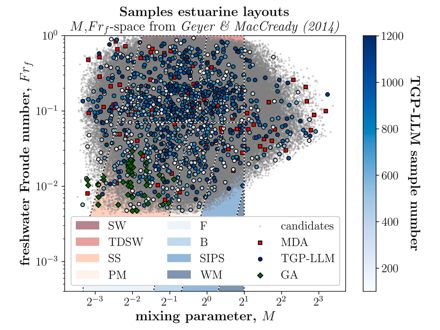
Recently, the DigiShape AI working group started organizing monthly DigiShape Online Technical Sessions. These are one-hour digital updates in which an expert gives an update on a specific digital topic in hydraulic engineering. On Sept. 20, 2023, Gijs Hendrickx of TU Delft gave a session on Machine Learning in hydraulic engineering, in which he talked about how such new techniques make expensive, process-based hydrodynamic models suitable for large-scale sensitivity analyses.
Gijs: "In hydraulic engineering, we often use process-based hydrodynamic models to analyze aspects of the water system. Think of predicting salt intrusion in estuaries or climate modeling. These models have numerous variables, all of which can theoretically be combined. However, most of these combinations yield little new information, although you don't always know that in advance. By looking adaptively at which combinations are interesting, you can save a lot of time and therefore money. In this case, adaptive means that you let the input depend on the output. For example, it was already known that river discharge and water depth play a major role in the salt intrusion length, but the effect of tidal flats and convergence were greater than we expected beforehand."
Currently, it is relatively expensive to do this kind of sensitivity analysis, so it is usually chosen to narrow down the number of options to a subset. In his doctoral research, Gijs has found a way for machine learning to do this. "I propose a process-based hybrid workflow, where the model analyzes its own results based on feedback loops and determines which simulations and inputs have the most value to run based on that." Based on this, in his own research on salt intrusion in estuaries, Gijs managed to reduce the number of simulations needed from over 1.5 million to 1250. That's a significant efficiency gain!
Following his presentation on this in the AI Online Technical Session, he received enthusiastic responses and requests from various quarters to further present the results and method, for example the Delft3D User Days. "It was very interesting to exchange thoughts with AI specialists on this topic," Gijs says, "but also that there is appreciation for what we have developed. This new method offers a great opportunity to work more efficiently and effectively with models. Not only in the water sector, but also beyond."
Want to know more? Download Gijs' paper at https://www.sciencedirect.com/science/article/pii/S0378383923000133 or contact him at Dit e-mailadres wordt beveiligd tegen spambots. JavaScript dient ingeschakeld te zijn om het te bekijken..
Want to organize your own AI Online Technical Session and gather input for your initiative on AI and the water sector? Contact DigiShape working group leader José Antonio Álvarez Antolínez at Dit e-mailadres wordt beveiligd tegen spambots. JavaScript dient ingeschakeld te zijn om het te bekijken..

